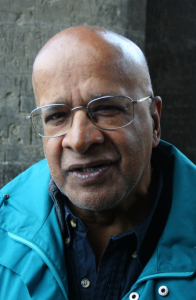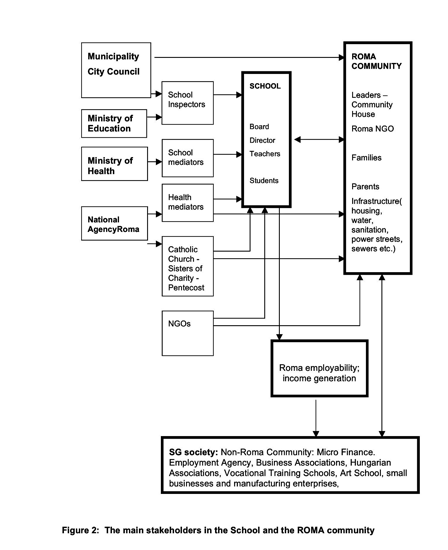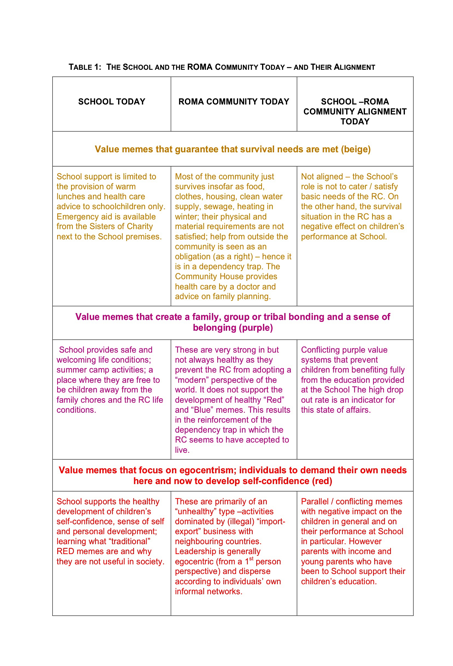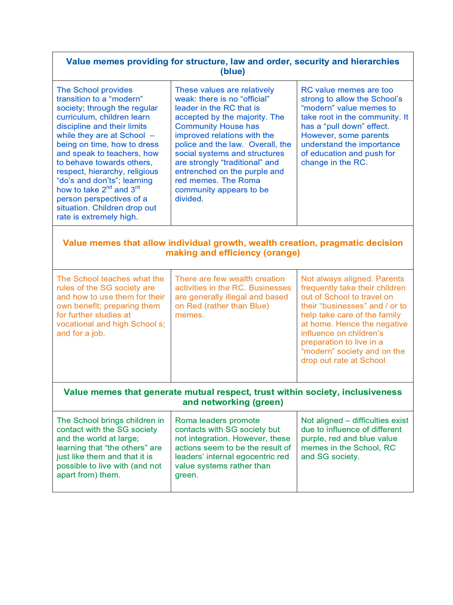Abstract
This article is about the sustainable and healthy human development along the path of human evolution—the Spiral. It is based on a broader study of the impact of a Roma school on the Roma (gypsy) community (RC) in the town of XY, Romania[1]. Using Spiral Dynamics Integral (SDI), Romanian and international policies and program supporting Roma communities were reviewed in order to assess their alignment (relevance) to the Roma community of XY—given its value systems, their stage of human development and their living conditions. The results provide a deeper understanding as to how and why only a few of these program have had either a significant or a sustainable impact on the human development process of Roma in Romania and in XY.
The article also focuses on a stakeholder analysis undertaken to locate on the Spiral the main stakeholders on the basis of a series of on site interviews. AQALs (all quadrants all levels) were constructed for each stakeholder in the School in relation to the surrounding Roma community; alignments and misalignments between them were identified. The article highlights the different value memes in action on a daily basis and provides a clearer understanding of how the present situation is unsatisfactory to all stakeholders in the Roma community and the town of XY. In particular it reveals the dynamic forces pushing/pulling in opposite directions along the Spiral. A Meshworkshop brought together the main stakeholders for the first time and yielded positive signs: a common overall view for the future of the Roma community and its school; and the co-operation required to transform the desired future situation into reality.
The article argues in favor of a long-term strategy for social integration taking into account the results of the Meshworkshop. The strategy would focus on the evolutionary change process of the School, Roma community (RC) and the XY society over at least a couple of generations—from the early to the later stages of the human development process. It concludes with a strong suggestion that working with SDI on international development is a considerable improvement to the current sole use of various forms of the Logical Framework Approach (LFA) for Project Cycle Management (PCM) that ignore people’s internal values, beliefs, emotions, attitudes, etc. For reasons of confidentiality, it is not possible to disclose in this article the names of stakeholders and places involved in the study.
Introduction – From the Logical Framework (LFA) TO Spiral Dynamics Integral (SDI)
An integral approach to international development constitutes another step in our journey towards quality of human development that began at an international organisation in Vienna, Austria[2]. In the 1990s, concern focused on the impact and sustainability of development co-operation programprograms, for which local ownership of the development process was considered imperative. Participatory approaches were the order of the day: the Logical Framework Approach (LFA) for planning, monitoring and evaluating project cycle management (PCM).
However, local ownership continued to be the exception rather than the rule and impact and sustainability proved to be illusive. More importantly, it did not consider the mind-set of people involved—namely their values and beliefs about the project, and the mission/vision, values and culture of all the organisations involved directly or indirectly in the project. We therefore decided to focus on the performance excellence of people and organisations—learning how to learn, effective communication taking into account the different perspectives of reality of those with whom we were communicating. In particular, we learned about the so-called “neurological levels” of personal excellence (Gregory Bateson, Robert Dilts and others). To focus on organisational excellence, we drew heavily from the European Excellence model[3] that we used to assess the organisational performance of UNIDO taking into account organisational values and culture.
In 2001-2003, we developed SAM (SevenPlus Systemic Alignment Model) for people and organisational performance excellence[4] on the basis of NLP techniques and the European Excellence model. SAM enabled us to determine what drives a person and an organisation—that is, their mission and purpose, their beliefs, values and organisational culture. It also enabled us to determine whether these are or are not aligned to their daily work practice—and so identifies what they need to change to improve their performance[5]. Yet, SAM did not enable us to understand the implication of different value systems nor did it show the importance of value memes in determining/influencing the behaviour of people and social groups within a country or across the world.
The work of Clare Graves, Don Beck, Chris Cowan, Ken Wilber and others seemed to show the way forward. SDI provides a tool for recording the internal value systems and the external actions, structures, systems of an individual stakeholder as well as the internal values and external structures and social systems of the collective in which that person lives. The information in these quadrants (AQAL) also reflects the corresponding stage of development (individual and the collective). A parallel between SAM and AQAL appeared—see Fig. 1 combining the 2 approaches:
 The Conceptual Framework for the Roma Study
The Conceptual Framework for the Roma Study
At the heart of the matter is the sustainability of healthy human development. Taking on new values and belief systems, attitudes, motivation and working traits on a permanent basis are the key to sustained change/development. At present there are precious few development program that include support to the internal side of stakeholders’ life that bring about sustained change.
Spiral Dynamics Integral (SDI) was used in this study to take into primary consideration those internal human factors that had to be identified, understood and taken into account when analysing the feasibility and social convenience of any measure, program etc., and when evaluating the requirements of a population for assistance, specific legislation, rules, regulations, etc.
The application of the SDI Framework can assist to:
- Enable sustainable and socially equitable development,
- Increase efficiency and individual freedom,
- Implement structure and rules where needed,
- Protect people from each other and engender respect between individuals and their sense of belonging to a group.
The Impact of Policies and Program Supporting Roma Integration
A review of international and Romanian policies and programin Romania suggested that they were primarily designed with “blue” and “orange” value memes in mind, and occasionally with “green”. However, it was found in this study that the Roma are primarily at the “beige” and “purple” stages of human development.
- On one hand organisation, structures and processes (blue) are necessary and helpful for establishing the necessary legal frameworks. So one could easily think this approach meets perfectly with the blue of organisation, structures and processes. Yes and no. Consider for example the steps taken by school inspectors to eliminate segregation. From the “Blue” perspective, classes or schools with almost 100% Roma children are not necessarily segregated classes or schools. For the school inspectors it is a form of regulation to keep people who do not live according to the rules of the majority within their own social group. As long as Roma do not integrate into the Romanian way of life, segregation is a normal result. As a result of this situation the school inspectors are often quite unaware that there is de facto segregation and of the necessity to take action, especially when there is no law that demands this.
- On the other hand people who work in governmental offices are mostly situated within the range of “red” to “orange” value memes. But many of these program come from an egalitarian (“green”) European perspective that requires that minorities have access to education and work that is equal to that of the majority population. Fostering “Green” ideas—egalitarian, anti-hierarchic, pluralistic values, multicultural, looking for harmony—on a post communist country that exists in a state of prolonged economic crisis does not relate to or coincide with the values and the needs of the people who were made responsible for implementing these program. These people themselves are undergoing a change for the worse, their salaries are low and have been reduced, which leads to a stronger egocentric (Red) attitude, looking for their own gains and opening doors for corruption. Egalitarian (green) values can only be built onto an established entrepreneurial efficiency (orange) that in turn must be built onto established structures and processes (blue) that cannot be sensibly introduced directly into a population at the “Purple” stage. Simply stated, they are not prepared; their development stage is not adequate.
- The other important focus of the external support program was on skills and behaviour. However, insofar as individuals are concerned, the focus has been on training for the acquisition of new/improved skills and competences, but these skills did not lead to an improved situation for the Roma. Because of the lack of job opportunities and discrimination they still did not find work. In addition, the amount of time required for school is taken from that demanded by parents for working in the field, trading and other indispensable income generation activities.
From their beige/purple perspective it is understandable that many Roma still do not appreciate the benefit of school education, resulting in reduced school attendance, early drop out and non-involvement of the members of Roma communities in school program. This demonstrates why the Strategy for the Improvement of the Condition of the Roma, adopted in 2001 was not significantly successful.
In short, the focus of attention has been on the external manifestations of human development. Program strengthening skills only fall into the upper right quadrant; those working to improve the systems by rules and regulations to improve the access of Roma to the society work within the lower right quadrant.
Relatively little consideration appears to have been given to the internal aspects of society and individuals, namely their thinking and learning styles, their values and beliefs, their motivation and working characteristics. The careful consideration and application of the concepts found within all four quadrants are required if sustainable human development and change are to be obtained.
The Roma Community—SDI was applied in the case of a Roma community (RC) of some 3,500-5,000 inhabitants and it’s School in a town (XY) of some 75,000 people in Romania. While both communities have relatively low levels of income by European standards, the Roma community lives in a state of poverty as evidenced by their income and education levels (if any), housing, nutrition, health services, infrastructure (water, sewage, power, streets, garbage collection).
The Main Stakeholders in the Roma and XY Community—that is, those with the authority to make decisions, those with power to prevent decisions from being made or to implement them, and those who can influence those with authority and/or power. They included people from government, local authorities, school teachers and students, churches, NGOs and the leaders and families on the Roma community.
In carrying out this study, interviews with those directly and indirectly involved were held on the basis of the sample questions in Fig. 3 below in line with each stage in human development from “beige” through to “green”.
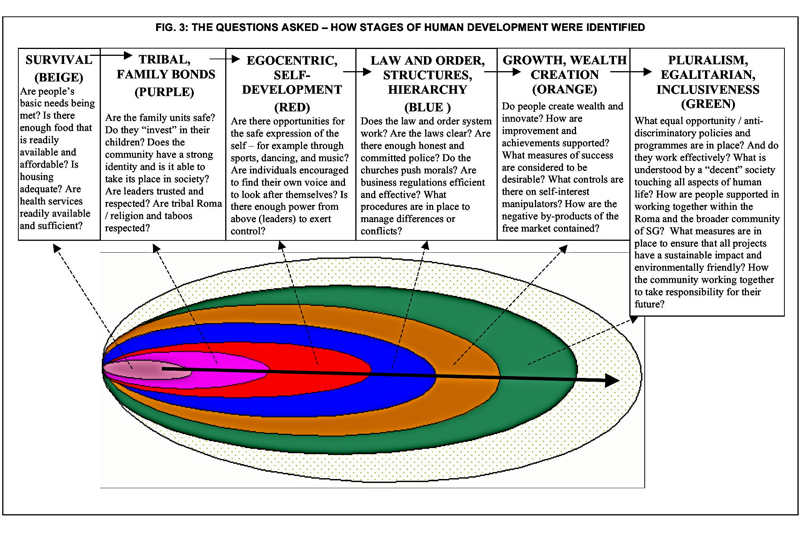 The interviews were designed to obtain information that was classified in three groups:
The interviews were designed to obtain information that was classified in three groups:
- The values, beliefs, attitudes, motivations of the main stakeholders (individual and collective)—that is, to identify their present stage of human development.
- The actions, responsibilities, structures, social systems of the main stakeholders (individual and collective).
- The values and beliefs embedded in Romanian and international policies/program and the extent to which these are aligned with the value systems, actions, structures and social systems of the stakeholders in the XY society.
It was then possible to identify alignments/misalignments between the individual and the collective and the extent to which they fit into their current living conditions (LCs). This allows for improved program identification, formulation, implementation and sustainable impact.
The School
- The School focuses primarily on modifying the “traditional” worldview of Roma culture and bringing children to a “modern” worldview. Its activities have had a healthy effect on their development.
- The impact of the School—while very positive—must be considered in context: only 2-3% of the children finish School having attained the programd levels of personal development. Thus, the impact on the RC is very good in qualitative terms but is quantitatively limited. Children may or may not remain in the RC. The successful students interviewed had no intention of staying.
- A greater impact of the School on the Roma community is heavily inhibited by its strong influence of the socio-economic-cultural situation. Notably it is the cultural norm that the attitudes of the parents are often counter-productive (Fig. 5).
- The greatest needs of the Roma community are found in the survival stage (beige) of human development. The School cannot—provide for these needs. Nor is it the schools function to do so. In addition, there is nothing that obliges the Roma community as a whole to think of or to want to change. For some families there is little incentive to even consider change, partly because the poorest (mostly unemployed) manage to survive with subsidies and handouts and charity from Government and from various NGOs outside the community; it would appear that being in a dependency trap is acceptable. Others are content to be engaged in trading (often illegally) in and outside Romania or to have irregular jobs locally.
- The situation is further complicated and confused by some aspects of NGO support. The support is notco-ordinated and is aimed indiscriminately at the various stages of human development without having identified the first priority: what needs to be supported is that which helps people help themselves. Additionally, there seems to be no sense of urgency in the RC for people to change their worldview which is largely from a 1st person perspective[6] and the acceptance of a dependency trap.
The Roma Community
The interviews were analysed by the GOAL team to determine (to the extent possible) the internal value systems and their external expression of the main stakeholders in the RC—School—XY system—as well as the stage of human development. Although illegible, the purpose of Fig. 4 is to provide the reader with an idea of the relative position of interview statements per quadrant and level. Further information on how this analysis was done and the results achieved can be obtained from the author.
UL – INTERNAL SCHOOL UR – EXTERNAL
LL – INTERNAL ROMA LR – EXTERNAL
COMMUNITY
Figure 4: Present situation of the School / RC system
This AQAL (all quadrants, all levels) made it possible to identify alignments/misalignments between the stages of human development of the School (individual) and RC (collective). It also indicates how the School’s activities (external – UR quadrant) impacts on the RC value systems (internal – LL quadrant). No attempt was made to include All Lines (cognitive, emotional, moral, interpersonal, spiritual, psychosexual,?) in the upper left quadrant of Fig. 4. Table 1 below provides a summary analysis of the contents of Fig. 4.
Table 1: Alignments and Misalignments.
While the above Table shows existing alignments and misalignments, the situation is a dynamic one with constant change. During the interviews, many people spoke about the generational change that is taking place in the Roma community today. Roma adapt to cope with the dramatic changes in their life conditions following the events of 1989. However, there is understandably—a strong resistance to changes in their culture, traditions, andlife style.
Fig. 5 below shows the “pull down-push up” forces prevailing in the human development process. International development needs to take these forces into account.

Figure 5: The Dynamics of the Current Situation of the SCHOOL / Roma system (Adapted from the original by Dr. Don Beck)
The black arrows show the direction in which the cultural forces acting on the School and the Roma community are pushing in general. However in some cases (purple – red, red – blue, blue – orange) they tend to push in opposite directions, thus constraining the impact of the School on the community.
The Main Findings
Insofar as supporting policies and program are concerned—be they Romanian or international—most of these have been aimed at the externally perceived symptoms so that much energy and funds are directed at processes, skills, structures etc., to change actions, behaviours, results. However, the root cause of these external symptoms are to be found internally in people’s mindsets, their thinking and learning styles, worldviews and social group traditions, cultures, values and beliefs. Support program have rarely included a consideration of these internal factors. When these factors have been identified it has perhaps been more by accident than by design.
Furthermore, each social group in the Roma community and XY society appears to take note only of the negative aspects of the others and as a result, each group tends to isolate the others thus increasing their fears. The continuation of this state of affairs makes progress ever more difficult and complex. Some (former) leaders are much distressed by the apparent lack of values in the Roma community, and hope that somehow they will be able to escape from this apparently impossible situation. Others outside the Roma community hope and suggest that a “miracle” will bring harmony between all the social groups.
But this is not realistic. The social groups have different sets of values and traditions and they are at different stages in the process of evolution. For change to be sustainable it must be the result of evolution and not of a highly improbable “miracle”. It may well take place through the interplay between, on the one side, the increasing problems, and on the other side the opportunities recently perceived by several stakeholders in the Roma community and XY society
Meshworks[7]
The Views of the Stakeholders on the present and future of the School and the Community
At the end of the site visit in June 2010, GOAL organised a Meshworkshop designed to bring together the main stakeholders—that is, those with the authority to make decisions on the School and the Roma community, with the power to prevent or to support such decisions, and/or with the capacity to influence either of these two. The Meshworkshop was held in Hungarian. Each participant was invited to write on a card their point of view concerning the following questions:
- What were the most important change(s) in the Roma community over the past few (e.g. 5) years?
- How did the School influence/contribute to these changes?
- What are the most important change(s) to be made in the future with regard to (a) the Roma community and (b) to the School?
- What is the best possible way toward co-operation between all stakeholders concerned with the School and the Roma community?
Knowing how divergent the views were on so many issues and people, the first step in this “meshing” process was only to have all stakeholders together in one room for the first time and to have them listen carefully and attentively to each other’s answers to the above questions. No attempt was made by GOAL to seek a consensus or agreement between the stakeholders at that time. The Meshworkshop proved to be very successful, as witnessed by the atmosphere created in the course of three hours and continued later over dinner.
The GOAL team later examined the statements written by the stakeholders at the Meshworkshop, sought clarification on some of them and placed them in the form of a hierarchy of objectives—a generic objectives tree—showing how all statements were somehow inter-related and indicating that there is hope for the future (see Fig. 6 below).
The objectives tree is by definition incomplete and at high levels of both generalisation and specificity in line with the worldview of the different stakeholders. It nevertheless constitutes a sound basis for the formulation of a long-term development program.
The GOAL team also sought to characterize the nature of the stakeholders’ objectives in terms of the value memes driving their desired improvement of the Roma Community and the School—thus the
colors of each box reflect the corresponding stage of human development. It is worthy of note that the values: “Family, Communal bonding” (purple) are at the lower part of the objectives tree and “Growth, Wealth creation” (orange) tends to appear at the upper part—the process of evolution seems to be reflected here as well.
N.B. Stakeholders at the Meshworkshop did not write any statements on how to start this process of development. The GOAL team therefore took the liberty to add at the bottom of the generic objectives tree 2 statements/boxes on the need for the existence of strong leadership and the respect for structures, systems and processes by all stakeholders. These are critical pre-conditions for starting a development process that is owned by the stakeholders and has a high probability of success in terms of its relevance, effectiveness and long term sustained impact.
Building the Future on Solid Foundations
Future support to the School and the Roma community must be based and built on the value memes of the people concerned. It must therefore focus on strengthening the health of the initial stages of the human development process. Only then can there be a chance of achieving sustainable change and development in the long term—as people transcend and include the value memes of previous stages and anticipate further changes in their living conditions.
Future support can build on the positive aspects in the School, the Roma community and the XY society:
- All stakeholders want to be gainfully employed and improve their living conditions (orange).
- All stakeholders have a more or less precise picture of the future situation for themselves (blue/orange).
- Most stakeholders have an idea of what needs to be done to reach their desired future situation (blue).
- The bases for improvement as expressed at the Meshworkshop are broadly compatible with each other (healthy purple).
Future support needs to take into account/resolve existing constraints:
- The strong Roma culture and values (unhealthy purple).
- The Roma community is divided—between “richer” and “poorer” families.
- People’s different levels of school education in the RC (if any).
- Fragmented community leadership, weak community structures and processes (unhealthy purple, red and blue).
- The accepted dependency of many in the community on handouts and subsidies (the so-called “dependency trap”—unhealthy beige).
Fig. 6 below illustrates the transformational process that could take place at the School and the Roma Community within the overall XY system—to support the generational changes that people seem to perceive at present, and to counteract the “conflict” between push-up and push-down forces that are identified in this report. The goal is to ensure the full ownership of local stakeholders. A long-term strategy can be designed to push for and build on the generational change that is taking place now in the RC. The plan should take into account the support of the increasing number of parents who have been to School and of those others who have increased their income. The harmonious integration of the RC community with the society of XY—can only be obtained as a natural way of life without the imposition of outside “recipes”. It will take generations for people to transcend and include value memes of earlier stages as they anticipate and progress to the next stage.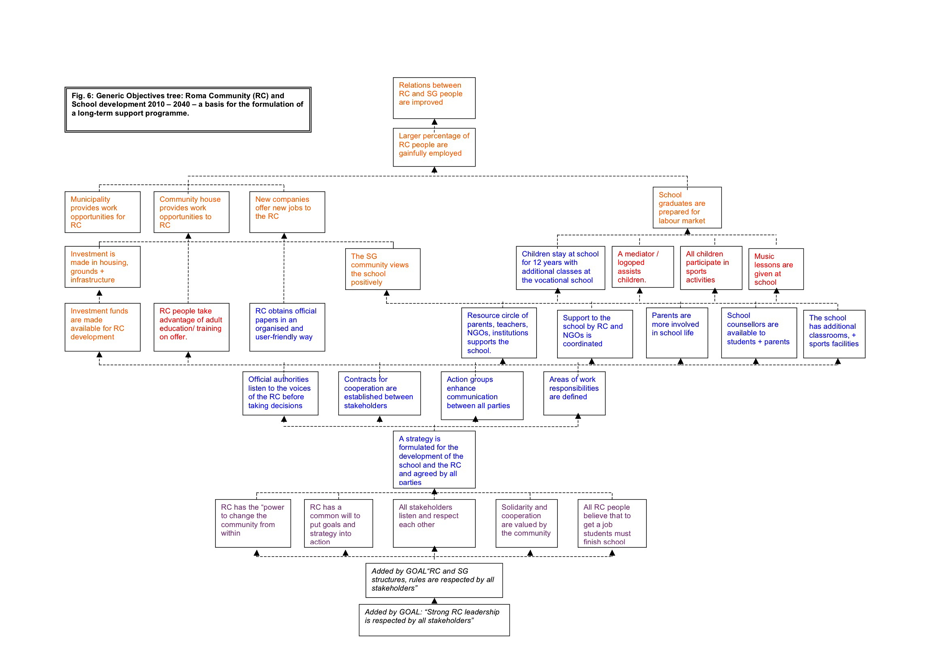 The team considers that these transformational changes may well require some 30 years of structured action coordinated and owned by the people of XY and its Roma community designed to strengthen the early stages of human development and develop the transformation to the later stages that contain the value systems that are required in order to enable the Roma and Hungarian populations of XY to cope harmoniously with the life conditions of today and for the future.
The team considers that these transformational changes may well require some 30 years of structured action coordinated and owned by the people of XY and its Roma community designed to strengthen the early stages of human development and develop the transformation to the later stages that contain the value systems that are required in order to enable the Roma and Hungarian populations of XY to cope harmoniously with the life conditions of today and for the future.
A Note of Caution
1. A critical pre-condition is that the Roma or any other community has strong and truly respected leadership to guide people along the human development process.
2. Our present society, organisations, processes are not geared to working over a 30 year period: most work on 2 year budgetary arrangements, staff need to show results in the immediate run, people do not normally work with a long term vision in mind, leaders’ and politicians’ vision focuses on 4-5 years at a time and usually with an egocentric rather than a socio-centric perspective.
Concluding Remarks on Spiral Dynamics Integral
Spiral Dynamics Integral has proven to be the most adequate approach to carrying out stakeholder analyses in general. It reveals how it is critically relevant to the success of a development program by making a clear distinction between the relative stages of human development of the stakeholders and by taking into account people and social groups’ internal value memes. The results achieved through this Study demonstrate that it is a more “powerful” tool than LFA/PCM when used by itself. Furthermore, SDI shows the way towards sustainable human well-being by transcending and including the value memes of early stages as well as anticipating the living conditions of the next stages in the human development process.
About the Author
Alexandre (Rico) de Faria and friends are primarily concerned with the evolution of people’s value systems, sustainable change and well-being on the basis of Integral Theory and SDI: (www.sevenplus.org). As Managing Director of GOAL—Global Options and Linkages (www.goalnetwork.net), a think-and-do tank in Vienna, Austria, Rico and friends carry out action-research projects using SDI. He also leads “Quality Performance” (www.quality-performance.eu), the consulting arm of GOAL, on the leadership and management of people and organizations across the world. Prior to 2000, as Chief of Project Appraisal/Quality Assurance at the United Nations Industrial Development Organisation (UNIDO), Rico worked over 15 years on the quality of management of international development program. He has a degree from the Graduate Institute for International Studies, Université de Genève, Switzerland. Contact: defaria@quality-performance.eu.
[1] Undertaken by GOAL – Global Options and Linkages, an international NGO based in Vienna, Austria – www.goalnetwork.net, supported by a foundation. The author wishes to thank other members of the GOAL team: Zsuzsa Gaspar, Teresa Salazar de Buckle, Elfriede Konas, Camilo Antonio and Emiliano Reyes. The team is indebted to Dr. Don Beck and Rachel Castagne for their guidance and support at the outset of the study.
[2] United Nations Industrial Development Organisation (UNIDO), www.unido.org
[3] The European Foundation for Quality Management, Brussels. www.efqm.org
[5] For example in 2003 – 2008 (see http://www.quality-performance.eu/Downloads.html)
- Organisational performance (values assessment of one Department at Heifer International and their alignment with tools, methods, procedures in daily work practice);
- Coco-Mat (assessment of values and their alignment with the daily work practice in a manufacturing company);
- For the combination of SAM with Project Cycle Management, see a manual on how to include people and organisational values; Intro to PCM http://www.quality-performance.eu/Downloads.html.
[6] 1st person perspective: “I see the situation from my personal point of view”; 2nd person perspective: “I see the situation from the other person’s point of view;” 3rd person perspective: “I see the situation from an outsider’s point of view.”
[7] “Meshwork” – recommended by Dr. Don Beck – suggests the notion of how to blend, align, integrate, stitch-together, merge, amalgamate, and coalesce. Individual entities will tend to lose their “egocentrism” and to contribute the best of what they are without becoming an indistinguishing element in a common task.. See also: http://www.integratedsociopsychology.net/meshworks-perspective-process.html

